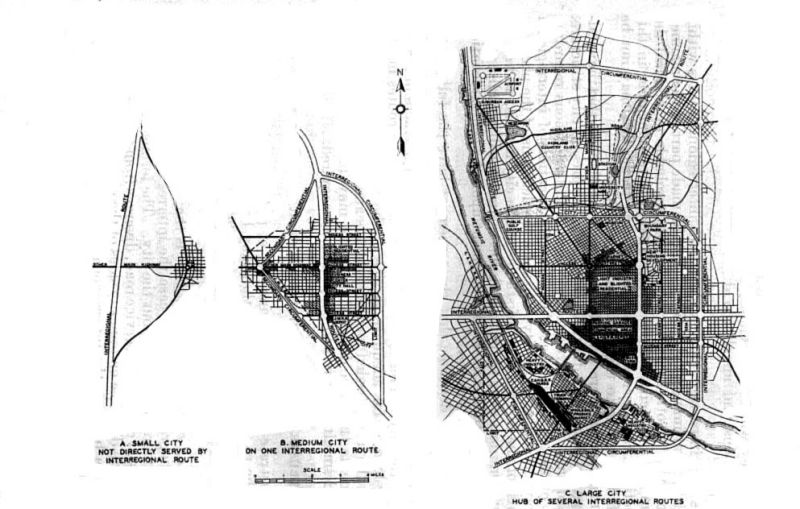
Schematic lay-outs Illustrating various combinations of main interregional routes required for the adequate service of traffic at cities of various sizes
At the small city: In this case the interregional highway passes on a direct course wholly without the city. The former main highway which now serves as a city service road, diverges from the interregional route at some distance on opposite sides of the city. Thus it provides a connection between the interregional and the other main highway that passes through the small city. The service road may or may not be considered as part of the interregional system, depending upon the size of traffic service road and the other main highway contribute to the interregional system. In this case, however, no circumferential or distributing routes needed.
In the city of medium size: In the case a single route of interregional system approaches the city from the north and south and necessarily passes through the city closely adjacent to the business section to pick up and deliver the substantial volume of traffic there originated or destined. For the accommodation of the considerable volume of through traffic on the interregional route, a circumferential route, considered as part of the interregional system, diverges to the right at a convenient point south of the city and passes along the eastern boundary to rejoin the main route at a point north of the city. The distance around the city by this route is little if any longer than the distance through the city by the main route. The circumferential route serves also to pick up and deliver traffic at several accesses provided in the city's eastern quarters. Another main highway, not included in the interregional system, intersects the interregional route at the center of the city. For transfer of through traffic between this route and the interregional route, a circumferential route in provided around the west side of the city, but because of its relative unimportance in the service of interregional traffic, this route is not considered as part of the interregional system.
In the large city: [The diagram] illustrates the complex pattern of main and circumferential interregional routes and other local traffic at a large city. In this case, three interregional routes intersect at the city and all must pass within convenient reach of the large central business section. One follows along the bank of the river as it approaches the city and continues in this location through the city. Another approaches from the northeast and enters the city through a wedge of undeveloped land, then passes on a north-south course along the border of a new housing development, skirts the eastern fringe of the business section, crosses the river, and finally resumes its southwesterly course as it emerges from the city. The third crosses the city from east to west, skirting the northern edge of the business section. In addition, several other principal highways center in the city. In this case, the three interregional routes combine to perform the function of traffic distribution around the business section. At convenient points to the north, east, south, and west of the city, interregional circumferential routes intersect the main penetrating routes and serve to transfer through traffic from one to another, and to distribute traffic to the several quarters of the city. The locations of these routes are such that in no case is the distance around the city materially different from the through distance. To the north of the city there is considerable scattered suburban development, and northern leg of the interregional circumferential route crosses east and west above all this development. An additional east-west distributor closer to the city is located as an inner circumferential route approximately along the northern city limits. It connects with the eastern interregional circumferential and with the riverside interregional route. Since it performs mainly a local distributing service, [the distributor] is not considered as part of the interregional system. Within the area circumscribed by the interregional circumferential routes, access is provided to the main interregional routes and the circumferential routes at several suburban communities and at certain streets which extend uninterruptedly across the city, and which for that reason are well adapted as internal collectors.
